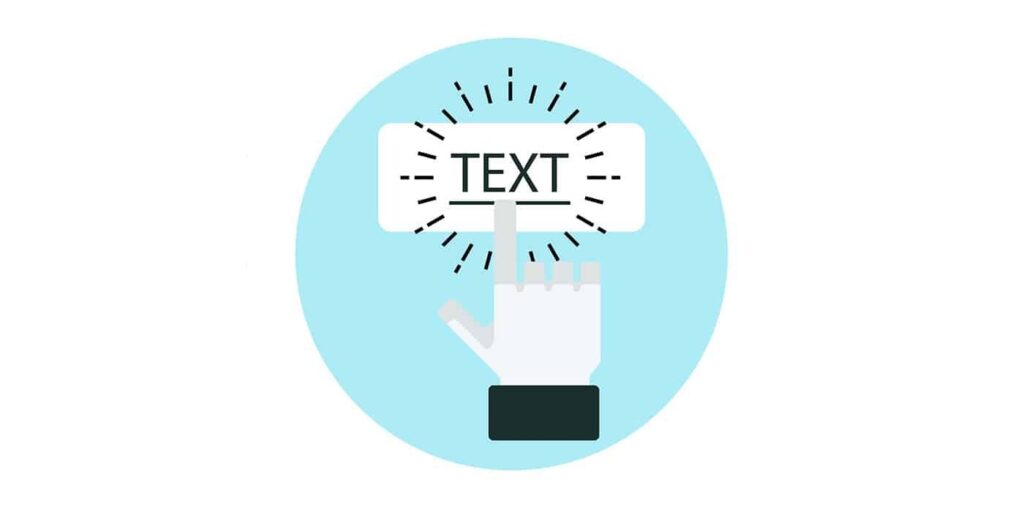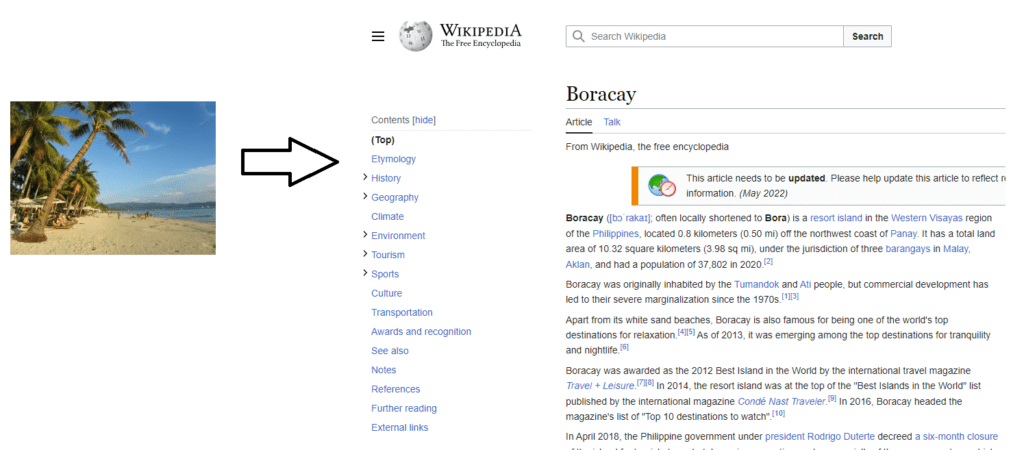Anchor text is an integral part of on-page optimization. It is the text you use to hyperlink to web pages and a ranking factor for your website in search engines.
In this blog post, we will discuss what anchor text is and how to optimize your anchor text for maximum results!

What is Anchor Text
Anchor text is what users see and click on when navigating a new web page or website, as it is the visible and clickable text in a hyperlink. It is also sometimes referred to as link text.
The term “anchor text” can also describe the text accompanying an image used as a link. In this case, the anchor text would provide context and additional information about the linked image.
Ideally, anchor text should be descriptive (but not keyword-stuffed), relevant, and easy to read. For example, if you’re linking to a page about dog food, the excellent anchor text might be “dog food,” “best dog food,” or “healthy dog food.”
Bad anchor text, on the other hand, is either irrelevant (like “click here”) or stuffed with keywords (like “cheap dog food”). Keyword stuffing looks spammy to users and can trigger penalties.
Anchor Text Example
Here is a code example of anchor text:
<a href="http://www.example.com">Example Anchor Text</a>Why Anchor Text is Important in SEO?
Anchor text is one of the most important elements of on-page SEO. For SEO, anchor text is a ranking factor that can help search engines understand the linked web page.
Anchor texts are essential also for usability. For usability, the anchor text that is descriptive and relevant can help users understand where it will take them if they click on a link.
You can optimize anchor text for both search engine visibility and user experience.
Types of Anchor Texts
You can use various types of anchor text to improve SEO and usability.
1. Generic Phrase
Generic phrases are the most common type of anchor text and are usually just a few words long.
Generic anchor phrases match the keywords people would use to search queries for your site.
Examples of link text of a generic phrase include “click here,” “read more,” or ” learn more.”

Generic anchor text can be helpful for usability, but it doesn’t give search engines much information about the link-to page.
2. Branded
Branded anchor text has a link text that includes the name of a brand or company. For example, “Apple,” “Nike,” or ” Starbucks.”

Branded links anchor text can be helpful for both SEO and usability.
Branded anchor texts are an effective way to build brand awareness and can be a good SEO strategy for new websites or businesses trying to establish themselves.
You can use branded anchor text to help brand recall if you have a more established website. If someone sees your brand name in the link text, they are more likely to remember your website and revisit it.
It can also help users understand the link’s destination if they click a link text.
3. Exact Match
The exact match anchor text is the anchor text that has an exact match of link text to the target keyword that you are trying to rank for.
For example, if you try to rank for the target keyword phrase “backlink checker,” your exact match anchor text would be “backlink checker.”
Exact match anchor text can be helpful for SEO.
Exact match anchors can be spammy anchor text if used too much, which will hurt your SEO.
4. Partial Match
Partial match anchor text is when the target keyword for your website is similar to the anchor text.
For example, if you are trying to rank for the keyword “blue shoes,” your partial match anchor text could be “buy blue shoes” or “shoes in blue.”
The above example does not have the same anchor text but contains partial match keywords.
Partial match anchor text can be helpful for SEO but can also be spammy if used too much.
5. Naked Link
A naked link anchor text is simply the URL of the link-to page. They are merely hyperlinks that don’t have any anchor text.
Example: https://aemorph.com/anchor-text/
Naked anchor texts can be helpful if you’re link-building to an internal page on your website.
These are not as effective for SEO because they don’t provide any context about the link-to page.
6. Image Link
Image links are clickable images that lead to another page on the web.
Image links are a great way to improve your website’s SEO because they provide a relevant and clickable link to another page on the web. It can be beneficial because it can help your website stand out from other sites.
Image links are easy to add to your website and can be a great way to improve your website’s SEO.
Example:

Anchor Text Best Practices
Anchor text makes a link readable and understandable for humans and is also critical in determining a web page’s relevance.
The anchor text is valuable in SEO.
That’s because anchor texts can give search engines clues about the topic of the linked-to page.
Optimize your anchor text as it helps that page rank higher in search results if it is relevant to the page.
1. Make it natural
To optimize your anchor text, you need to make it look natural and blend in with the surrounding content on the page.
Ensure that your anchor text looks natural on the page. It means that the link text should blend in with the surrounding content and not stand out as being obviously “keyword-stuffed.”
There are several reasons to make the anchor text look natural:
It helps with the optimization of search engines.
When the anchor text is optimized, it can help improve a website’s ranking SERPs. Anchor text is a factor in the Google algorithm for determining rankings.
It can increase click-through rates (CTRs).
Anchor text matters because it can help entice users to click on a link text. It can lead to higher CTRs, which can, in turn, lead to more traffic for a website.
It can create a better user experience.
Anchor text optimized for users and search engines can help make a website more user-friendly. It can lead to better engagement and conversions on a website.
2. Make sure that the linked-to-page is relevant
Choosing relevant anchor text that accurately describes the page you are linking to is essential. It will help users understand where they are being taken when clicking on the link and can also help enhance your website’s SEO.
If you’re linking to a page about dog food, your anchor text shouldn’t be “click here.” A better option would be “dog food,” “best dog food,” or “natural dog food.”
Not only is relevant anchor text helpful for search engines, but it’s also more user-friendly.
If users see “click here” as the anchor text, they might not know what to expect from the linked page. But if the anchor text is descriptive, the user will have a better idea of what they’ll find when they click through.
3. Avoid excessive use of anchor text
When it comes to anchor text, more is not always better. Keyword stuffing can do more harm than good.
Excessive use of anchor text can be seen as spam by most search engines and result in your website being penalized. That’s why it’s essential to use various types of anchor text and evenly distribute them throughout your website.
Therefore, using anchor text wisely is essential, as too much or too little can negatively affect your website.
Instead, focus on creating natural-sounding anchor text that accurately reflects the content of the page you’re linking to.
4. Remember to include image alt tags
Image alt tags might seem small, but they can be crucial in SEO. Here’s why we should not neglect image alt tags:
Image alt tags provide context for search engines.
A search engine crawls a website and relies on text to understand the page. However, sometimes, there will be images on a page without any accompanying text. In these cases, the image alt tags can provide context to help the search engine understand the page.
Screen readers use image alt tags.
Screen readers convert text into speech, so people who are blind or have low vision can still access website content. The screen reader will use the image alt tag in reading and providing context for the image.
Image alt tags can help improve your website’s accessibility.
By making sure to use image alt tags, you can help improve the accessibility of your website. It is crucial not only for people with disabilities but also for people who might be using an older browser or have a slow connection that doesn’t display images.
Image alt tags can help improve your website’s SEO.
Search engines use various factors to determine where a website should rank in the search results. While using image alt tags doesn’t guarantee that your website will rank higher, it is one crucial ranking factor.
Image alt tags can help improve the usability of your website.
Users often scan a website rather than read it word for word. Including a relevant target keyword in your image, and alt tags can help ensure that your pictures are correctly labelled and easy to find. It can enhance the overall usability of your website.
5. Don’t link from toxic sites
If you’re linking to toxic sites, it can hurt your website’s ranking and reputation. That’s why it’s essential to know the risks of linking to toxic sites and take steps to avoid them.
There are some ways to determine if a site is toxic. One way is to use Google’s Safe Browsing Tool. This tool checks websites against Google’s database of unsafe websites and returns a warning if the site is dangerous.
Another way to check for toxicity is to use a tool like Majestic SEO’s Site Explorer. These free tools allow you to check the link profile of a website and see if any red flags indicate the site may be toxic.
If you’re linking to a site that you suspect may be toxic, you can do a few things to minimize the risk. First, consider using a rel=”nofollow” attribute on the link. It commands search engines not to follow the link and, therefore, not to count the link as a signal of the page’s content.
You can also add a redirect on your server that will send any traffic from the toxic site to another page on your own site. It will prevent visitors from landing on the toxic site and help prevent search engines from indexing it.
Finally, you can contact the webmaster of the toxic site and ask them to remove the link to your website.
Conclusion
Search engine optimization as digital marketing has various ways to improve. Optimizing anchor text is just one of them. Anchor text links to new web pages or websites. It is essential to have clickable text that is visible to users and gives them an idea of the linked page.
If you’re looking to improve your website’s SEO, it’s essential to have your keyword research and use anchor text wisely.
To optimize your website, you need to keyword-rich anchors throughout your site. It will help search engines understand your site and index it accordingly.
Final thoughts, anchor text, is an essential part of SEO, but it’s only one piece of the puzzle. Many other factors contribute to a website’s success in search engine rankings. But if you use keyword-rich anchors, you’ll be well on optimizing your site for the search engine.









